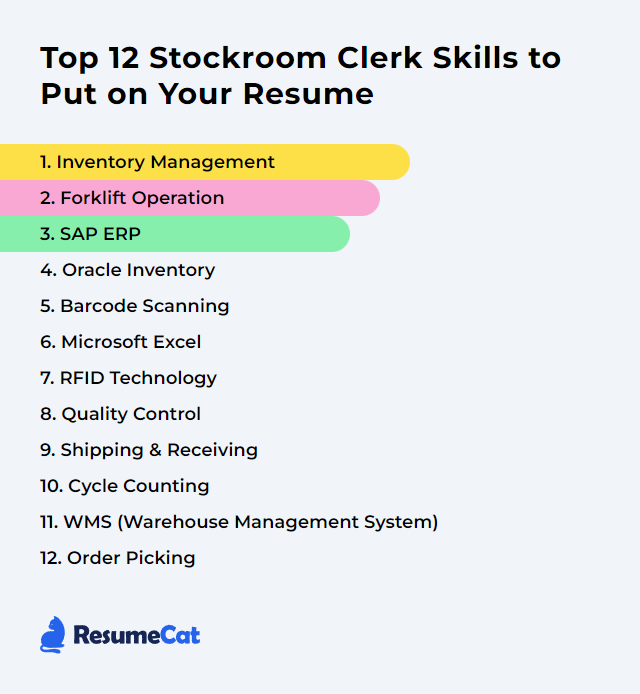Top 12 Stockroom Clerk Skills to Put on Your Resume
In today's crowded job market, a stockroom clerk who actually shines does two things well: masters the mechanics of inventory and shows it clearly on the resume. Put real skills on display, the ones that move goods faster, keep counts tight, and keep operations humming without drama.
Stockroom Clerk Skills
- Inventory Management
- Forklift Operation
- SAP ERP
- Oracle Inventory
- Barcode Scanning
- Microsoft Excel
- RFID Technology
- Quality Control
- Shipping & Receiving
- Cycle Counting
- WMS (Warehouse Management System)
- Order Picking
1. Inventory Management
Inventory management for a Stockroom Clerk means tracking, organizing, and controlling stock levels so the right items are available without clogging shelves, while records stay accurate and storage space stays sane.
Why It's Important
It keeps counts correct, cuts carrying costs, prevents stockouts and excess, and speeds order fulfillment. That ripples straight into customer satisfaction and bottom-line health.
How to Improve Inventory Management Skills
Make it tighter, simpler, faster with these moves:
Use an Inventory System: Choose software that supports real-time stock updates, receiving, picking, and forecasting. Mobile-friendly is a plus.
Run Regular Audits: Reconcile physical counts with system data. Catch drift early; fix root causes, not just numbers.
Apply FIFO (or FEFO): Move older stock first; for perishables, use first-expired-first-out. Label locations and dates. Keep it visible.
Set Reorder Points: Build min/max levels using usage rate, lead time, and safety stock. Review seasonally, not once-and-done.
Strengthen Supplier Cadence: Confirm lead times, agree on packaging standards, and set clear delivery windows. Reliability beats speed when planning counts on it.
Kaizen the Process: Track shrink, adjustments, and pick errors. Trim steps, improve layouts, and iterate based on data.
Do this, and your inventory behaves. Less guesswork, more flow.
How to Display Inventory Management Skills on Your Resume

2. Forklift Operation
Operating a forklift as a stockroom clerk means moving, lifting, stacking, and staging heavy items safely, accurately, and without beating up product—or people.
Why It's Important
It compresses time, expands reach, and keeps materials flowing. Done right, it boosts productivity and reduces risk.
How to Improve Forklift Operation Skills
Safer, smoother, sharper:
Safety First: Follow OSHA-compliant training, wear PPE, and complete pre-shift inspections. No shortcuts with stability or visibility.
Smart Layout: Widen aisles where possible, mark traffic lanes, and standardize pallet orientations. Fewer tight turns, fewer scrapes.
Maintenance Rhythm: Stick to scheduled checks—brakes, forks, chains, batteries, hydraulics. A quiet truck is a reliable truck.
Refresher Training: Practice precision placement, odd loads, and ramp work. Simulate real constraints, then raise the bar.
Pair With Tech: Use clear labeling and location systems (barcodes/RFID). Less hunting, more hauling.
The outcome: faster turns, fewer incidents, cleaner aisles.
How to Display Forklift Operation Skills on Your Resume
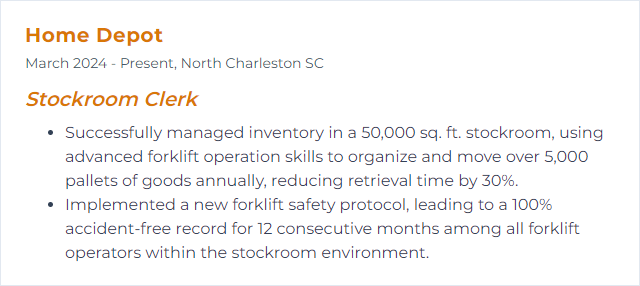
3. SAP ERP
SAP ERP unifies core business processes—procurement, inventory, receiving, fulfillment—so stock movements are tracked end-to-end with fewer gaps and cleaner data.
Why It's Important
It centralizes inventory truth. That means accurate levels, timely reorders, controlled costs, and fewer fire drills.
How to Improve SAP ERP Skills
Turn the system into a force multiplier:
Enable Scanning: Use barcodes for receipts, moves, and picks. Faster inputs, fewer fat-finger errors.
Automate Replenishment: Configure min/max and safety stock. Let the system flag or trigger orders before bins go dry.
Custom Dashboards: Surface live KPIs—backorders, aging stock, open POs, bin accuracy—so decisions happen now, not next week.
Mobile Access: Put tasks on handhelds. Receive, relocate, and count right where the work happens.
Ongoing Training: Keep up with updates and best practices. Small tweaks compound.
IoT Where It Fits: Sensors for high-value or high-velocity items tighten accuracy and visibility.
Clean data in, sharp insights out. That’s the game.
How to Display SAP ERP Skills on Your Resume

4. Oracle Inventory
Oracle Inventory provides tools to track items, transactions, and locations—so receipts, issues, transfers, and adjustments stay aligned with reality.
Why It's Important
Real-time, reliable counts power timely picking and purchasing, cut carrying costs, and steady fulfillment.
How to Improve Oracle Inventory Skills
Sharpen the signal, reduce the noise:
Protect Data Quality: Record every movement at the point of work. Standardize transaction reasons and codes.
Get Trained: Learn the screens you live in—receipts, reservations, on-hand inquiry, min-max planning—and the shortcuts that save hours.
Cycle Count with Intent: Schedule counts by ABC class, investigate variances, and fix process leaks causing them.
Tune Min/Max: Base settings on usage, lead time, and variability. Revisit after seasonality shifts.
Use Reports: Review slow movers, negative balances, and pending transactions. Clear them out routinely.
Cross-Functional Sync: Align with purchasing and sales so demand and lead-time assumptions match reality.
Scan Everything: Barcodes (or RFID) for receipts and moves reduce errors and speed up throughput.
Better inputs. Fewer surprises. Smoother days.
How to Display Oracle Inventory Skills on Your Resume
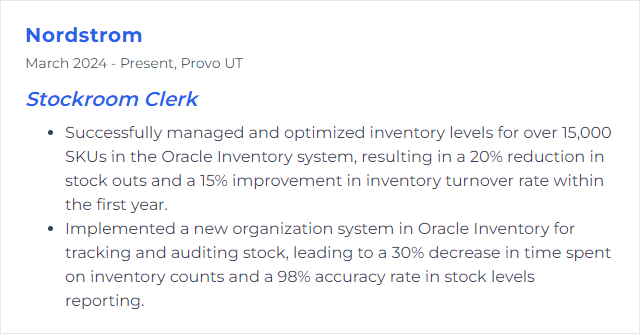
5. Barcode Scanning
Barcode scanning captures item data instantly from labels, feeding systems with clean, fast inputs for receiving, putaway, moves, and picks.
Why It's Important
It slashes keystrokes and mistakes, accelerates transactions, and strengthens inventory accuracy without bogging people down.
How to Improve Barcode Scanning Skills
Make every beep count:
Pick the Right Hardware: Handhelds for mobility, presentation scanners at stations, rugged units where drops happen.
Print Clean Labels: High-contrast, correct size, durable stock for your environment (cold, dusty, abrasive).
Light It Well: Good lighting reduces misreads. Aim for glare-free, evenly lit scan zones.
Train Technique: Angle, distance, and aim matter. Short practice, long payoff.
Integrate Tightly: Ensure your WMS/ERP updates in real time. No batch lags, no mystery moves.
Maintain Regularly: Clean lenses, update firmware, and test batteries. A dull scanner slows a whole line.
Speed plus accuracy—no tradeoff required.
How to Display Barcode Scanning Skills on Your Resume
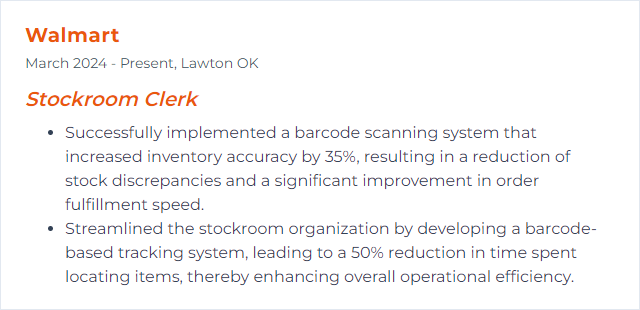
6. Microsoft Excel
Excel is the everyday workhorse for lists, counts, and quick analysis—great for ad-hoc inventory tracking, reconciliations, and audit prep.
Why It's Important
It turns raw data into decisions. Track stock, analyze movement, and flag issues before they grow teeth.
How to Improve Microsoft Excel Skills
Practical skills that pay off fast:
Inventory Sheets: Structure item masters, locations, and transactions. Use data validation to prevent typos.
Formulas: Master SUMIFS, COUNTIFS, XLOOKUP/VLOOKUP, and IFERROR. Automate reorder points and on-hand calculations.
PivotTables & Charts: Spot trends, slow movers, and variance patterns at a glance.
Conditional Formatting: Highlight low stock, expired lots, or negative balances instantly.
Shortcuts & Cleanup: Keyboard shortcuts, flash fill, and text-to-columns save hours.
Templates: Build reusable sheets for receiving logs, cycle counts, and discrepancy tracking.
Less manual crunching, more clarity.
How to Display Microsoft Excel Skills on Your Resume
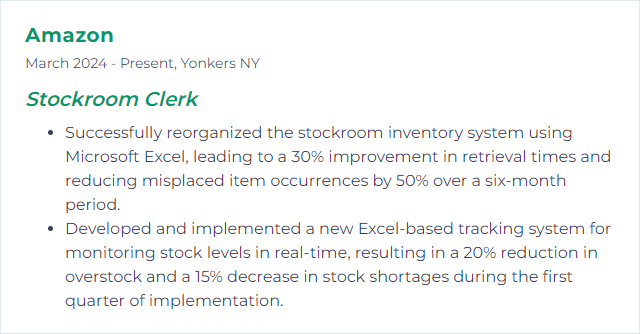
7. RFID Technology
RFID uses radio waves to identify tagged items without line-of-sight, enabling quick, bulk reads for fast audits and location checks.
Why It's Important
It shrinks counting time, raises accuracy, and boosts visibility—especially in high-velocity or high-mix environments.
How to Improve RFID Technology Skills
Make RFID pull real weight:
Use UHF Tags: Longer range and faster reads suit most stockrooms. Match tag type to surfaces and conditions.
Integrate with Systems: Sync reads directly into WMS/ERP. No siloed scans, no manual merges.
Tag Quality & Placement: Durable labels, consistent placement. Test before rolling out wide.
Coverage Matters: Multiple antennas or read points eliminate blind spots. Map the room, then the signals.
Train and Tune: Teach operators how to sweep, read, and verify. Adjust power levels and filters for your space.
When dialed in, it feels like x-ray vision for inventory.
How to Display RFID Technology Skills on Your Resume
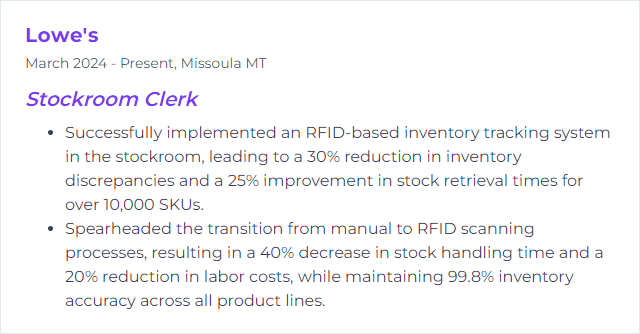
8. Quality Control
Quality control means verifying incoming goods meet specs, documenting accurately, and keeping the stockroom clean and organized so product stays saleable.
Why It's Important
Fewer defects, fewer returns, fewer headaches. Accuracy and condition protect margins and trust.
How to Improve Quality Control Skills
Build consistency and catch issues early:
Write Clear SOPs: Receiving checks, labeling, storage conditions, and nonconformance handling—make it unambiguous.
Use Real-Time Tracking: Log receipts, lot numbers, and expirations on arrival. Traceability isn’t optional.
Train Regularly: Short, frequent refreshers beat one big annual session. Show examples of good vs. rejectable.
Audit Routinely: Spot-check bins, dates, and packaging integrity. Verify documentation matches what’s on shelves.
Sampling & Checks: Apply AQL or risk-based sampling where volume is high. Document findings, close loops.
Feedback Loop: Feed problems back to purchasing and suppliers. Fix the source, not just the symptom.
Quality is a habit, not a task at the door.
How to Display Quality Control Skills on Your Resume

9. Shipping & Receiving
Receiving brings goods in, verifies them, and slots them correctly. Shipping picks, packs, and sends orders out clean and on time.
Why It's Important
It’s the gateway in and out. Accuracy here keeps inventory right, orders complete, and customers happy.
How to Improve Shipping & Receiving Skills
Fewer errors, faster flow:
Digitize the Process: Scan receipts and picks into your system immediately. Paper lags cause count drift.
Standardize: SOPs for checks, damage handling, labeling, and documentation. Consistency beats heroics.
Barcode Everywhere: Receive to location with scans, not memory. Validate during packing.
Train and Cross-Train: Cover peak hours and absences without chaos. Versatility speeds recovery.
Quality Gates: Inspect at receiving; verify at packing. Problems caught early don’t metastasize.
Layout for Flow: Clear staging zones, first-in-first-out lanes, and unobstructed paths. Movement should feel obvious.
Audit Cadence: Regular counts and shipment checks keep the numbers honest.
Ship what you say you have, when you say you will. Reliability wins.
How to Display Shipping & Receiving Skills on Your Resume
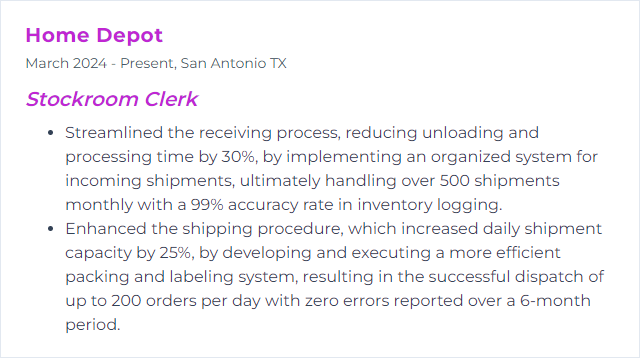
10. Cycle Counting
Cycle counting means checking small subsets of inventory on a schedule instead of freezing operations for a full physical count.
Why It's Important
It preserves accuracy without the shutdown, surfaces process issues fast, and keeps orders flowing.
How to Improve Cycle Counting Skills
Turn counting into a steady drumbeat:
ABC Prioritization: Count high-value/high-velocity items more often. Not all parts deserve equal attention.
Scan to Verify: Use barcodes or RFID to validate locations and quantities. Paper tallies invite errors.
Schedule Smart: Count during slow windows. Lock locations while counting to prevent double-handling.
Train Counters: Clear methods for recounts, variance thresholds, and escalation. Consistency = trustable results.
Fix Causes: Analyze variances and correct upstream process gaps—receiving, labeling, or picking.
Accuracy rises. Surprises fall. Operations keep moving.
How to Display Cycle Counting Skills on Your Resume
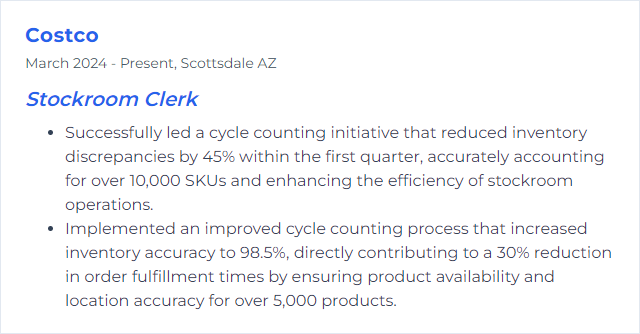
11. WMS (Warehouse Management System)
A WMS coordinates the stockroom: locations, tasks, picking methods, and confirmation steps all stitched together in one workflow.
Why It's Important
It cuts wasted motion, lifts accuracy, and gives leaders real-time visibility. Less chaos, more control.
How to Improve WMS (Warehouse Management System) Skills
Get more from the system you already own:
Real-Time Capture: Tie in barcode/RFID scanning so every move updates instantly.
Go Mobile: Use handheld apps for receiving, moves, and picking. Work happens on the floor, not at a desk.
Voice or Light Assist: Voice-directed or pick-to-light options speed picks and cut errors.
Automate Replenishment: Trigger bin refills based on min levels or demand signals. Empty slots are expensive.
Continuous Training: New features and small tweaks add up. Encourage user feedback and iterate.
Analyze, Then Act: Review reports on pick accuracy, travel time, and bottlenecks. Change slotting or waves accordingly.
Integrate Upstream: Connect with suppliers for ASNs and standardized labels. Smoother receiving, cleaner data.
The right settings turn a WMS from record-keeper to accelerator.
How to Display WMS (Warehouse Management System) Skills on Your Resume
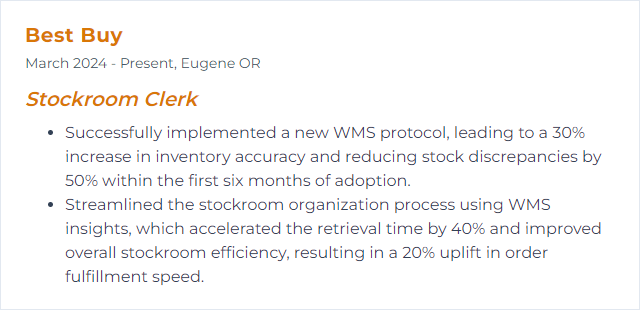
12. Order Picking
Order picking is the hunt-and-gather of warehouse work—locating items, confirming the right ones, and getting them staged for pack-out.
Why It's Important
It drives order accuracy and speed. Misses here echo loudly downstream.
How to Improve Order Picking Skills
Faster paths, fewer errors:
- Design for Flow: Slot high-velocity items close together; minimize travel and crossings.
- Scan Verification: Confirm picks with barcodes. Accuracy before speed; then both.
- Batch or Wave Picking: Group orders to reduce back-and-forth. Choose the method that fits your mix.
- Pick-to-Light or Voice: Guide pickers to exact spots. Less thinking, more doing.
- Train Technique: Teach tote organization, double-check habits, and ergonomic handling.
- Inventory Discipline: Keep locations accurate so pickers trust the map.
- Review and Refine: Track error codes and re-slot problem SKUs. Small changes, big gains.
The right layout plus the right cues turns picking into a smooth sprint.
How to Display Order Picking Skills on Your Resume

